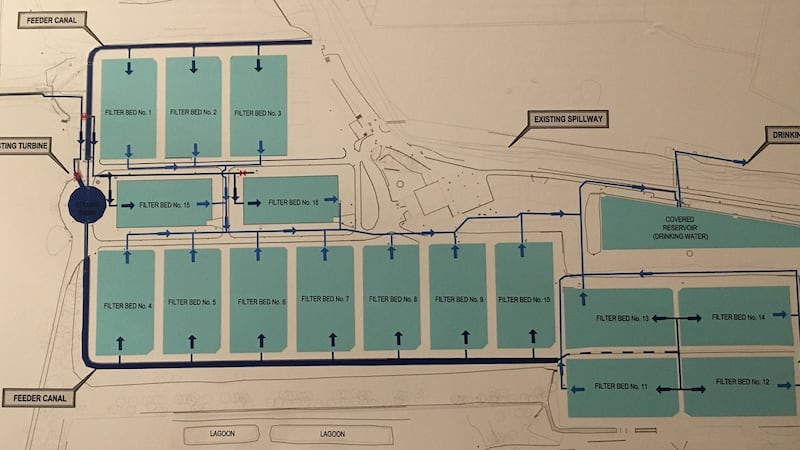Irish Water's plans to build a new water treatment plant at the Vartry Reservoir in Co Wicklow did not contain enough information, including an environmental impact statement, to allow for an assessment as to the likely impact it would have on the Vartry River, an oral planning hearing was told Tuesday.
The perceived deficiencies in the plans were highlighted by Brian Beckett, the eastern river basin district director of Inland Fisheries Ireland (IFI), one of several objectors who have appealed to An Bord Pleanála against a Wicklow County Council's decision to grant permission for the project.
He was among several people giving evidence to the hearing in the Glenview Hotel in the Glen O’The Downs, Co Wicklow.

“We have concluded in the first instance,” said Mr Beckett, “that there is insufficient information provided [by Irish Water] to assess the likely impact of the development on the River Vartry and secondly that the application is deficient in that it does not provide a detailed Environmental Impact Statement which would allow a full environmental assessment of the development.”
The river is an important salmon, sea trout and trout river and objectors to the plan include a river protection society, an angling club, local businesses, including Mount Usher Gardens and Avoca, the retail chain that has a branch in the gardens, and several local residents through whose land the river passes.
Seriously impaired
Mr Beckett said that because of the reservoir, built in the 1860s, the flow of water in the river downstream from the man-made lake was already “seriously impaired”.
Irish Water (IW) has proposed to release, on a daily basis, five million litres of water into the river from the reservoir which the utility says will guarantee a volume of water at all times and that this will be sufficient to provide for the river and surrounding habitat. However, Mr Beckett said that IW’s own data, submitted with their application, showed that between 2008 and 2015, the average daily release of water into the river was 10.5 million litres per day, during which time several locations along the river went from “good” to “high” in terms of their ecological status, as defined in the EU water framework directive .
"IFI believe it is potentially highly significant," he said, "that the improvement in the ecological status at Ashford and Newrath Bridge from Good to High has corresponded with the period of higher average flows."
IW had not provided data to show that a discharge into the river of 5 million litres per day was sufficient and there should be an environmental impact report into the plan, he said.
Rory Mulcahy, SC for IW, said that “all available evidence is that from 1998 up until 2008”, during which period the average discharge flow into the river was 4.6 million litres per day, the Vartry river was in good status, as defined by the water framework directive.
He asked if IW accepted this and Mr Beckett said he did but added this did not necessarily maximise the river’s potential as a salmon producing river.
Mr Mulcahy said that “credible evidence”, including the closure of a defective water treatment plant near Newrath Bridge that had been discharging sewerage into the river, showed the river achieved a good status with the injection of 4.6 million litres of water a day, less than IW was now proposing.
“Isn’t the obvious conclusion that if the river was able to achieve good status then, it will achieve good status under the proposal?” he asked.
“With respect,” replied Mr Beckett, “we’re not applying for planning permission.”
140,000 visitors a year
Konrad Jay, owner, with his wife Katherine, of Mount Usher, said the new treatment was needed and he did not oppose it. He was disappointed, however, with the planning process.
“I am simply someone who lives on the river,” he said.
The gardens at Mount Usher, laid in the 1880s, were “unique in Ireland” and contained one of the finest collection of mature plants and trees “whose survival is dependent on the river”. They attracted 140,000 visitors a year, employed some 70 people full and part-time and Avoca had also invested heavily in the location.
“It is a significant asset to the county and I feel very strongly that it merits a degree of protection,” he said.
Change must be put beyond “all scientific doubt” before permission granted. Wicklow Council had not insisted on a proper, appropriate and independent assessment of the “disingenuous” IW proposal, he said.
Everything had been done by the council piecemeal to “avoid assessing [the proposal] properly”, he charged.
That was a theme taken up by solicitor for the objectors, Alan Doyle. They did not want to stop the development, he insisted.
“We are not trying to prevent some repair or renewal of the Vartry plant,” he said. “but what we are trying to ensure is that it happens after an environmental assessment, not after a prolonged exercise that there is no need for such an assessment.”
That assessment, he insisted, should examine the entire reservoir system, including the 20th century additional reservoir for which he said no statutory basis appeared to exist, the Callow Hill tunnel, and pipes “all the way to Stillorgan”.
The hearing continues Wedneday and An Bord Pleanála is expected to give a decision on the appeal in September.








